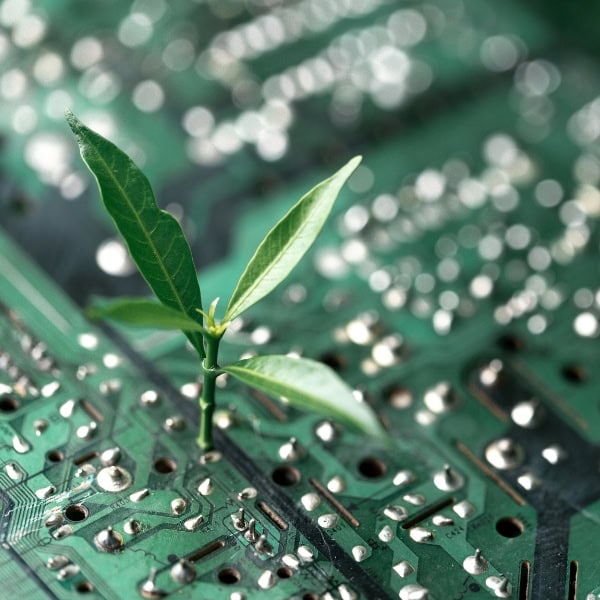
6 ways technology can protect the planet in your beauty business
By Rebecca Hitchon | 23 April 2024 | Feature, Sustainability & the environment, Technology

Researchers have estimated that by 2025, the IT industry could use 20% of all electricity produced and emit up to 5.5% of global carbon emissions. But just as technology has the ability to increase energy usage and emissions, it can help to decrease them. A study conducted by the World Economic Forum and IT & consulting company, Accenture, found that digital technologies could reduce emissions by up to 20% by 2050 for sectors producing the most greenhouse gases.
While the role of a nail or beauty professional is largely practical, you wouldn’t be able to organise appointments, converse with clients and get your brand known without digital technology. So how can you better support the environment when using tech?
1. Calculate your efforts
How can you know how to improve your sustainability efforts, if you’re not sure about the difference you’re making in the first place? There are many apps available to track your environmental impact, such as energy usage and carbon footprint, and provide suggestions to improve it.
One of those is Greenspark. Via the platform, which can be integrated into a range of technologies, solo workers, teams and their clients can manage and track the eco effects of their time in the salon. Businesses can help fund climate projects, from tree planting and carbon offsetting to implementing renewable energy sources and reducing plastic waste, every time a customer makes a purchase.
Another is EcoWise from sustainability consultancy, SaveMoneyCutCarbon. The app offers a programme for small and large businesses to audit, track and lower their carbon output in the workplace and at home. It features interactive assessments and 52 educational articles per year, and also shares tips on how staff can be more sustainable, while offering them discounts on eco-friendly homeware.
2. Assess products and brands
Consider whether the technology products you buy and brands you use are environmentally friendly. Look for EPEAT and Energy Star certified equipment to choose the most energy efficient models, and when searching for technology partners, such as broadband providers and cloud computing solutions for storage, do research into their eco credentials. Do they use renewable energy? What claims do they make, and can they be backed up?
3. Break habits
What may seem like insignificant technology habits, can be habits with big impact. For example, screen savers do not save energy: they waste electricity and reduce battery life. Most devices have energy-saving settings, or go one step further and turn off devices when they’re not in use. Opt for laptops or tablets rather than desktop computers, as they consume less energy. Also consider your salon wi-fi. Routers consume roughly the same amount of energy, whether you’re online or not, so consider turning yours off when your premises is vacant.
Emails are a surprising energy devourer, too. Research in 2019, commissioned by OVO Energy, revealed that the UK could reduce its carbon output by over 16,433 tonnes if each adult sent one less unnecessary email per day. The research cites ‘thank you’, ‘have a good weekend’ and ‘you too’ among the 10 most unnecessary emails. Emails are also stored in the cloud, which is powered by electricity, so deleting and unsubscribing from irrelevant ones makes a difference.

SaveMoneyCutCarbon research reveals that acting on climate change is important to 93% of employees’ sense of motivation and wellbeing, and 34% would increase their loyalty to employers if more information on how to be greener is provided.
4. Get your team involved
Sustainability is a collaborative effort: something that is expertly demonstrated by the Giki Zero app. Working with businesses of all sizes, the Giki Zero programme engages and educates employees via a collective carbon footprint calculator, sustainability guides, challenges, live events and consistent support from the Giki team. Plus, brand leaders can join the Chief Greenie community to learn from other organisations.
5. Switch your searches
What if I said you could plant trees and support climate initiatives by searching on the internet? Search engine and mobile app, Ecosia, allows you to do just that. Funded by advertising and with searches powered by solar panels, the company uses 100% of profits to donate towards tree planting and climate action. When searching using Ecosia, the platform highlights green results, as well as those from companies supporting fossil fuels. It also rates the climate pledges of companies.
6. Muse over music
It’s useful to consider how you listen to music in the salon. While CDs might seem like something from the stone age compared to streaming options available today, they do have environmental benefits. An Energy Saving Trust report found that streaming music is estimated to use 107 kW hours of electricity per year, costing around £15 to run – compared to a CD player which uses 34.7 kW hours per year, costing £5. However, CDs are known for being difficult to recycle.

Read the latest issue









